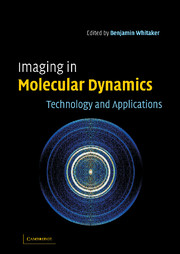Book contents
- Frontmatter
- Contents
- List of contributors
- Preface and acknowledgements
- List of abbreviations
- Part 1 Technology
- 1 Charged particle imaging in chemical dynamics: an historical perspective
- 2 Velocity map imaging: applications in molecular dynamics and experimental aspects
- 3 Reconstruction methods
- 4 Orientation and alignment
- 5 Time resolved cameras
- 6 3-D Imaging technique – observation of the three-dimensional product momentum distribution
- 7 Photoelectron and photoion imaging with femtosecond pump-probe time clocking
- Part 2 Applications
- Index
3 - Reconstruction methods
Published online by Cambridge University Press: 07 August 2009
- Frontmatter
- Contents
- List of contributors
- Preface and acknowledgements
- List of abbreviations
- Part 1 Technology
- 1 Charged particle imaging in chemical dynamics: an historical perspective
- 2 Velocity map imaging: applications in molecular dynamics and experimental aspects
- 3 Reconstruction methods
- 4 Orientation and alignment
- 5 Time resolved cameras
- 6 3-D Imaging technique – observation of the three-dimensional product momentum distribution
- 7 Photoelectron and photoion imaging with femtosecond pump-probe time clocking
- Part 2 Applications
- Index
Summary
Introduction
Charged particle imaging provides us with very beautiful pictures that offer graphic insight into chemical dynamics. Although it is often the case that general dynamical information can be deduced by simple inspection of the primary data, the images obtained in the typical imaging experiment are, in fact, projections of a three-dimensional (3-D) object onto a two-dimensional (2-D) screen. In order to extract all the information potentially available to us we need to consider what data recovery techniques are available to reconstruct the 3-D velocity distribution of the charged particles created in the experiment from the image we actually record.
There are two fundamentally different approaches; inversion methods and forward convolution methods. Inversion methods make use of the fact that if the original (3-D) distribution has an axis of cylindrical symmetry its (2-D) projection parallel to this axis contains enough information to unambiguously reconstruct the full (3-D) distribution. As we have seen in the previous two chapters, such an axis of symmetry in laboratory space can be found in many photodissociation or bimolecular scattering experiments. However, if there is no cylindrical symmetry in the experiment, a forward convolution method is generally necessary. Here, the experiment is simulated in a computer model that produces (2-D) data that are then compared with the experimental data. By iteratively optimizing parameters in the computer model the best reconstruction of the experimental data is sought.
- Type
- Chapter
- Information
- Imaging in Molecular DynamicsTechnology and Applications, pp. 65 - 112Publisher: Cambridge University PressPrint publication year: 2003
- 4
- Cited by

